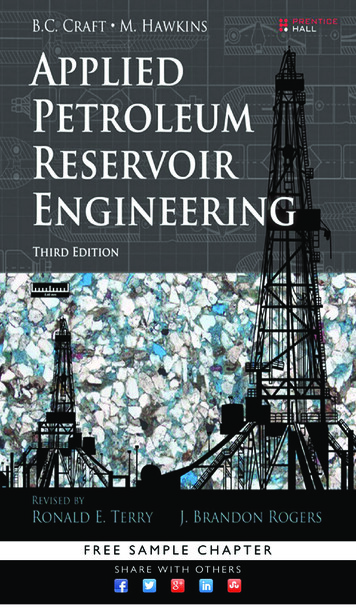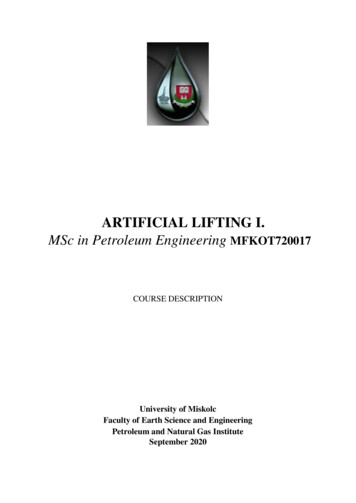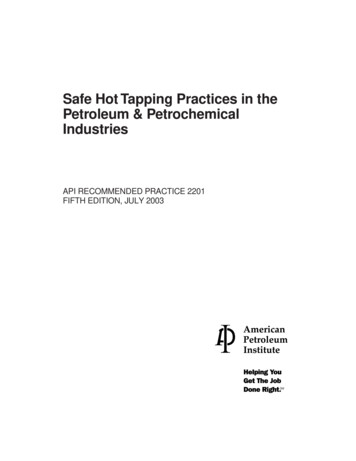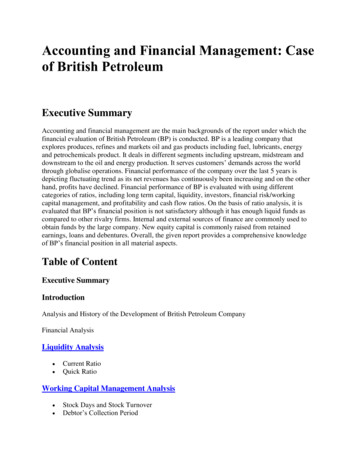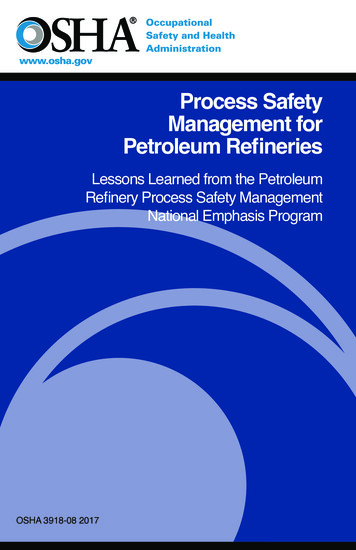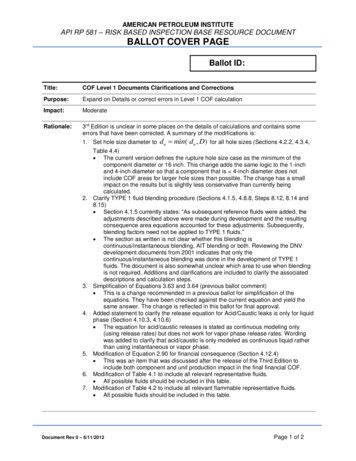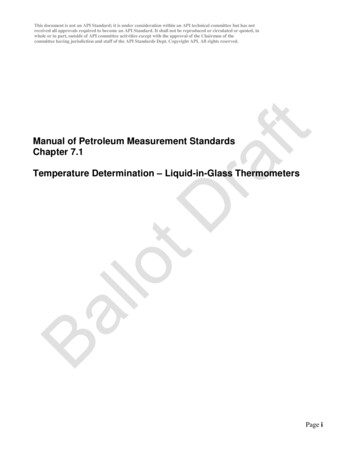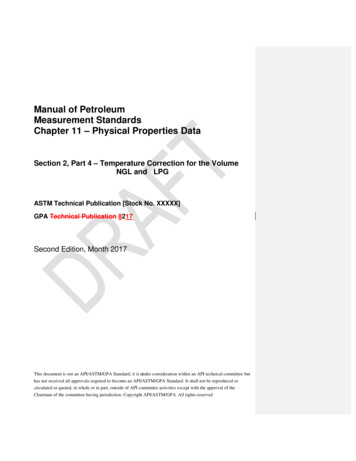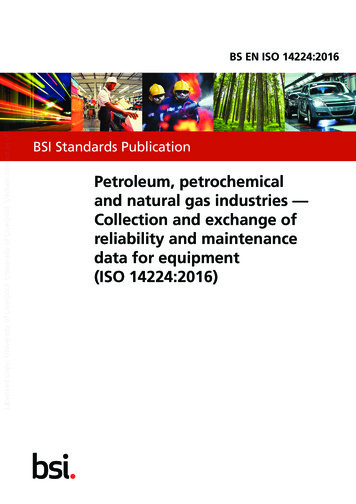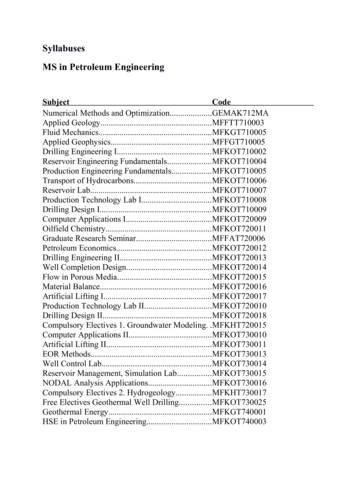
Transcription
SyllabusesMS in Petroleum EngineeringSubjectCodeNumerical Methods and Optimization.GEMAK712MAApplied Geology.MFFTT710003Fluid Mechanics.MFKGT710005Applied Geophysics.MFFGT710005Drilling Engineering I.MFKOT710002Reservoir Engineering Fundamentals.MFKOT710004Production Engineering Fundamentals.MFKOT710005Transport of Hydrocarbons.MFKOT710006Reservoir Lab.MFKOT710007Production Technology Lab I.MFKOT710008Drilling Design I.MFKOT710009Computer Applications I.MFKOT720009Oilfield Chemistry.MFKOT720011Graduate Research Seminar.MFFAT720006Petroleum Economics.MFKOT720012Drilling Engineering II.MFKOT720013Well Completion Design.MFKOT720014Flow in Porous Media.MFKOT720015Material Balance.MFKOT720016Artificial Lifting I.MFKOT720017Production Technology Lab II.MFKOT720010Drilling Design II.MFKOT720018Compulsory Electives 1. Groundwater Modeling. .MFKHT720015Computer Applications II.MFKOT730010Artificial Lifting II.MFKOT730011EOR Methods.MFKOT730013Well Control Lab.MFKOT730014Reservoir Management, Simulation Lab.MFKOT730015NODAL Analysis Applications.MFKOT730016Compulsory Electives 2. Hydrogeology.MFKHT730017Free Electives Geothermal Well Drilling.MFKOT730025Geothermal Energy.MFKGT740001HSE in Petroleum Engineering.MFKOT740003
Course Title: Numerical Methods andCode: GEMAK712MAOptimizationResponsible department/institute: GEMANInstructor: Dr. Józsefné MészárosPosition in curriculum (which semester): 1Pre-requisites (if any): No. of contact hours per week (lecture Type of Assessment (examination/ practicalseminar): 1 1mark / other): practical markCredits: 2Course: full timeCourse Description:Upon completing the course, students shall understand the relation between engineering andmathematics; comprehend important concept of solution methods using both analytical andnumerical techniques when the problems can be formulated using differential equations, system oflinear equations and system of nonlinear equations. In addition, students shall be able to apply theoptimization techniques to various engineering problems. Extrema of functions. Unconstrained andconstrained optimization. Convex optimization, Minimization of functions with one variable (goldensection, parabola method). Minimization of multivariable functions (Nelder-Mead, Newton, modifiedNewton, quasi-Newton, minimization with line search). Methods of penalty functions. Multiaidedand multicriteria decision problems (Pareto efficient solutions). Linear programming. About SoftComputing (SC) methods: fuzzy systems, genetic algorithms, neural network. Numerical solutions ofordinary differential equations and system of equations: Runge-Kutta, predictor-corrector, finitedifferences.Assessment and grading:Students will be assessed with using the following elements.Attendance:15 %Short quizzes10 %Midterm exam40 %Final exam35 %Total100%Grading scale:% valueGrade90 -100%5 (excellent)80 – 89%4 (good)70 - 79%3 (satisfactory)60 - 69%2 (pass)0 - 59%1 (failed)Compulsory or recommended literature resources: Égertné, M. É., Kálovics, F., Mészáros, G.: Numerical Analysis I.-II. (Lecture notes), MiskolciEgyetemi Kiadó (1992), 1-175. R. Fletcher: Practical Methods of Optimization, John Wiley &Sons, 2000. P. E. Gill, W. Murray, M. H. Wright: Practical Optimization, Academic Press, 1981. J. Nocedal, S. J. Wright: Numerical Optimization, Springer, 2000. Galántai Aurél-Jeney András: Numerikus Módszerek; Miskolci Egyetemi Kiadó, 1997. Galántai Aurél: Optimalizálási módszerek; Miskolci Egyetemi Kiadó, 2004.
Course Title: Applied GeologyCode: MFFTT710003Instructor: Dr. Éva HartaiResponsible department/institute: MFFTTPosition in curriculum (which semester): 1Pre-requisites (if any): No. of contact hours per week (lecture Type of Assessment (examination/ practicalseminar): 2 1mark / other): examinationCredits: 3Course: full timeCourse Description:The inner structure of Earth. Plate tectonics and hydrocarbon generation. Hydrocarbon-geologicalaspects of magmatic, sedimentary and metamorphic rocks. Generation of hydrocarbons. Primary andsecondary migration. Characteristics of reservoirs. Porosity, permeability, the effects of grain sizeand sorting. Trapping mechanisms trap types. Carbon-dioxide storage in geological reservoirs.Assessment and grading:Students will be assessed with using the following elements.Attendance:5%Homework10 %Short quizzes10 %Midterm exam40 %Final exam35 %Total100%Grading scale:% valueGrade90 -100%5 (excellent)80 – 89%4 (good)70 - 79%3 (satisfactory)60 - 69%2 (pass)0 - 59%1 (failed)Compulsory or recommended literature resources: Stoneley, R.: Introduction to Petroleum Exploration for Non-geologists. Oxford University Press,1995, ISBN 0 19 854856 7 Landes, K. K.: Petroleum Geology. John Wiley & Sons, 1959 Pápay, J.: Development of Petroleum Reservoirs. Akadémiai Kiadó, 2003, ISBN 963 05 7927 8
Course Title: Fluid MechanicsInstructor: Dr. Elemér BobokCode: MFKGT710005Responsible department/institute:GMTSZ/KFGIPre-requisites (if any): Type of Assessment (examination/ practicalmark / other): examinationCourse: full timePosition in curriculum (which semester): 1No. of contact hours per week (lecture seminar): 3 0Credits: 3Course Description:Kinematics. Conservation of mass. Balance Equations of momentum. Perfect Fluid Flow. Euler’sequation. Bernoulli equation. Elements of gas dynamics. Bernoulli equation with friction. Laminarand turbulent flow in pipes. Determination of pressure losses. Moody’s diagram. Pressure losses ingas transporting pipe-lines.Assessment and grading:Students will be assessed with using the following elements.Attendance:5%Homework10 %Short quizzes10 %Midterm exam40 %Final exam35 %Total100%Grading scale:% valueGrade90 -100%5 (excellent)80 – 89%4 (good)70 - 79%3 (satisfactory)60 - 69%2 (pass)0 - 59%1 (failed)Compulsory or recommended literature resources: E. Bobok: Fluid Mechanics for Petroleum Engineers. Elsevier, Amsterdam, London, New York,Tokyo, 1993. ISBN: 10: 0-444-98668-5 V. L. Streeter, E. B. Wylie, K. W. Bedford: Fluid Mechanics. WCB/McGraw-Hill 1998, ISBN 007-062537-9 R. Bird, W. Stewart, E. Lightfoot: Transport Phenomena. John Wiley and Sons, New York,2007. ISBN: 978-0-470-11539-8 Bobok E.: Fluid Mechanics. 2013. Streeter W. et. al: Fluid Mechanics, Auckland: McGraw-Hill, 1983.
Course Title: Applied GeophysicsCode: MFFGT710005Instructor: Dr. Gábor PethőResponsible department/institute: MFGFTPosition in curriculum (which semester): 1Pre-requisites (if any): No. of contact hours per week (lecture Type of Assessment (examination/ practicalseminar): 2 1mark / other): examinationCredits: 3Course: full timeCourse Description:The most important geophysical parameters used in HC exploration. Geophysical explorationmethods and their resolutions. Geophysical methods detecting HC in direct or indirect way. Timelapse (including 4D) geophysical measurements. Physical bases and instrumentation of bore-holegeophysical measurements. The main features of wire line logging, logging while drilling andproduction well logging. The determination of porosity, permeability, water and HC saturation. Logindicators of overpressured zones. Technical measurements and their applications. Informationgained by logging in cased holes. Detecting well problems. Application of logging in injection,production and monitoring wells. Geophysical case histories including exploration and production.Assessment and grading:Students will be assessed with using the following elements.Attendance:5%Homework10 %Short quizzes10 %Midterm exam40 %Final exam35 %Total100%Grading scale:% valueGrade90 -100%5 (excellent)80 – 89%4 (good)70 - 79%3 (satisfactory)60 - 69%2 (pass)0 - 59%1 (failed)Compulsory or recommended literature resources: Sheriff R.E., Geldart L.P. : Exploration Seismology 2nd Edition, Cambridge University Press,New York, ISBN-10 0-521-46826-4, 1995. Bacon M., Simm R., Redshaw T.: 3-D Seismic Interpretation, Cambridge University Press,Cambridge, ISBN 978 0 521 71066, 2003. Serra O.: Well Logging and Reservoir Evaluation, Technip, Paris, ISBN 978-2-7108-0881-7,2007 Schlumberger: Cased Hole Log Interpretation Principles/Applications, SchlumbergerEducational Services, Houston, 1989
Course Title: Drilling Engineering I.Instructor: Dr. Tibor SzabóCode: MFKOT710002Responsible department/institute:OMTSZ/KFGIPre-requisites (if any): Type of Assessment (examination/ practicalmark / other): examinationCourse: full timePosition in curriculum (which semester): 1No. of contact hours per week (lecture seminar): 3 0Credits: 3Course Description:The main subjects of the curriculum: tubing string design, recommended torque for threadedcoupling, tubing elongation, tubing movements, introduction of packer types, calculation of packerforces, connection between tubing and packer, well completion tools selection, perforatingtechniques, control the formation damage, well completion fluids, gravel pack techniques, formationstimulation, hydraulic fracturing, matrix acidizing, coiled tubing operations, wireline operations,nitrogen operations, well completion quality control.Assessment and grading:Students will be assessed with using the following elements.Attendance:5%Homework10 %Short quizzes10 %Midterm exam40 %Final exam35 %Total100%Grading scale:% valueGrade90 -100%5 (excellent)80 – 89%4 (good)70 - 79%3 (satisfactory)60 - 69%2 (pass)0 - 59%1 (failed)Compulsory or recommended literature resources: H. Rabia: Oilwell Drilling Engineering. Principles and Practice. Graham Tratman Ltd. London1995. 322 p. Howard B. Bradley: Petroleum Engineering Handbook, Third Printing, Society of PetroleumEngineers, Richardson, TX, U.S.A. 1992. Drilling Data Handbook, Edition Technip, Paris ISBN 2-2108-0756-4, 1999. 542 p. Erik B. Nelson: Well Cementing. Schlumberger Educational Services. Second Edition, HoustonTexas, 2006 H. Dale Beggs: Gas production operation. OGCI Publications, Tulsa, 1984. Arthur Lubinski (Edited by Stefan Miska): Development of Petroleum Engineering I-II. GulfPublishing Company, Houston, 1987.
Course Title: Reservoir EngineeringCode: MFKOT710004FundamentalsResponsible department/institute: AFKIInstructor: Dr. Tibor BódiPosition in curriculum (which semester): 1Pre-requisites (if any): No. of contact hours per week (lecture Type of Assessment (examination/ practicalseminar): 3 0mark / other): examinationCredits: 3Course: full timeCourse Description:Basic terms of porous media filtration. Continuity law. Governing equations of slightly compressibleflow. Multiphase flow. Steady-state flow. Complex potential. Conformal mapping. Superposition.Non steady-state, transient flow. Immiscible, two phase flow, frontal oil displacement.Assessment and grading:Students will be assessed with using the following elements.Attendance:5%Homework10 %Short quizzes10 %Midterm exam40 %Final exam35 %Total100%Grading scale:% valueGrade90 -100%5 (excellent)80 – 89%4 (good)70 - 79%3 (satisfactory)60 - 69%2 (pass)0 - 59%1 (failed)Compulsory or recommended literature resources: Craft and Hawkins: Applied Petroleum Reservoir Engineering, Prentice Hall, 1991, ISBN 0-13039884-5 Towler: Fundamental Principles of Reservoir Engineering, SPE Textbook Series, Vol.8., 2002,ISBN 1-55563-092-8 T. Ahmed: Advanced Reservoir Engineering, Gulf Publishing Co. 2005, ISBN-13: 978-0-75067733-2 T. Ahmed: Reservoir Engineering Handbook, Gulf Publishing Co., 2001, ISBN 0-88415-770-9 L. P. Dake: Fundamentals of Reservoir Engineering, Elsevier, 1978, ISBN 0-444-41830-X János Török, Lipót Fürcht, Tibor Bódi: PVT Properties of Reservoir Fluids. (Book). Universityof Miskolc Miskolc, Hungary 2012. ISBN 978-963-661-988-5 p. 1-192
Course Title: Production EngineeringCode: MFKOT710005FundamentalsResponsible department/institute:Instructor: Dr. Gábor TakácsOMTSZ/KFGIPosition in curriculum (which semester): 1Pre-requisites (if any): No. of contact hours per week (lecture Type of Assessment (examination/ practicalseminar): 3 0mark / other): examinationCredits: 3Course: full timeCourse Description:Introduction to artificial lifting: history, main features, comparison. Components of the sucker-rodpumping system: downhole pumps, sucker-rod string. Mechanical design of the sucker-rod string,failure modes. Surface equipment, pumping units, unit geometries, kinematics of pumping units.Gearboxes, prime movers.Calculation of operational parameters of rod pumping: approximate models. Dynamics of rod strings.The API RP 11L model: calculation accuracy, application ranges. Simulation of the sucker-rodstring’s behavior. Forms of the one-dimensional wave equation, solution methods, calculation ofdownhole cards. Torsional analysis of pumping units, optimum counterbalancing. Design of thepumping system, selecti
The API RP 11L model: calculation accuracy, application ranges. Simulation of the sucker-rod string’s behavior. Forms of the one-dimensional wave equation, solution methods, calculation of downhole cards. Torsional analysis of pumping units, optimum counterbalancing. Design of the pumping system, selection of the optimum pumping mode. Intermittent pumping. Analysis of the pumping system’s .
